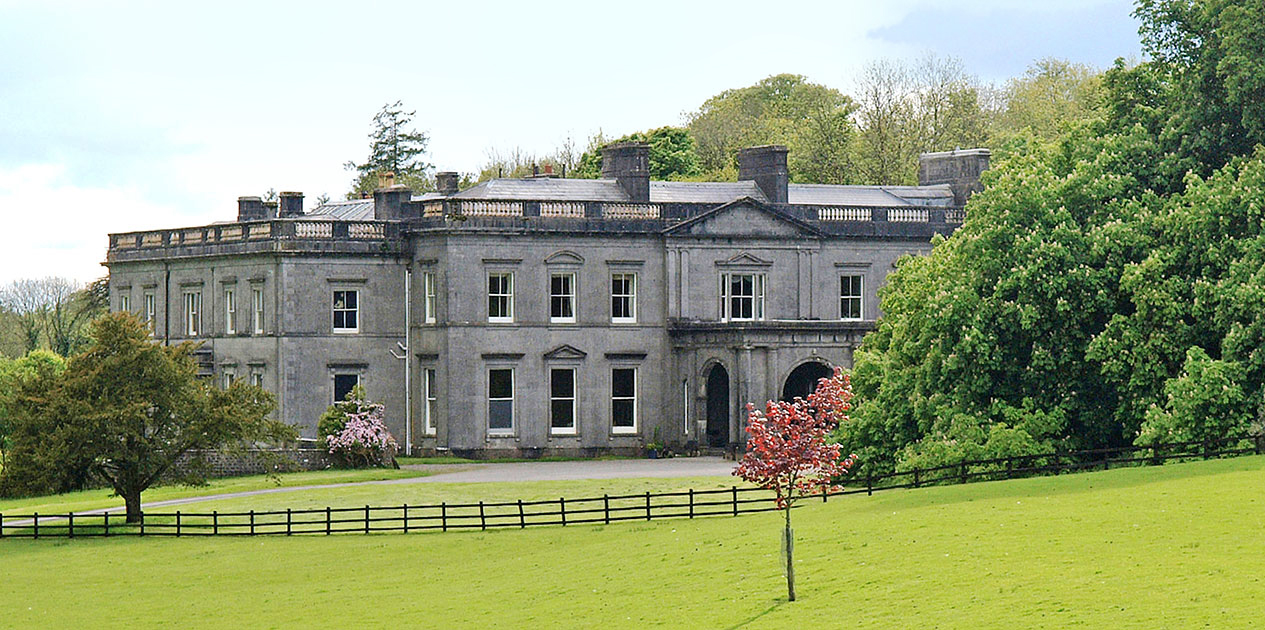Temple House
Temple House, near Ballymote in County Sligo, overlooks a Templar’s castle and a large lake from the centre of a heavily timbered estate. The classical cut stone house dates from the mid-nineteenth century but the earlier house can be identified in the centre of the east front. The interior has a superb suite of very large, grand rooms, lit by serried ranks of plate-glass windows. There are lofty ceilings (the vestibule rises to almost 32 feet) and decoration reminiscent of the grander London clubs, while much of the furniture was commissioned for the house.
The estate takes its name from the Knights Templar, the wealthiest of the three military orders founded during the crusades. Fierce warriors and able administrators, their power stretched across Europe where they operated as a separate sovereign administration within each independent kingdom. The knights reached Ireland with the Normans and quickly became established, building a castle at Temple House in County Sligo, their most westerly foundation, shortly after 1200.
In 1312 the Pope suppressed the order, citing their alleged heretical and blasphemous practises in justification. In France Templars were burnt at the stake and their land seized by the crown but other countries adopted a more measured approach, transferring their property to the Knights Hospitallers, known today as the Knights of Malta.
As English influence waned in the remote west of Ireland, Temple House was reoccupied by the O’Haras, the principal native sept of the region, who built a new castle, which still exists in ruins, beside the lake, in 1360. In 1565 William Crofton was appointed Auditor and Escheator General, and used his position to amass extensive estates in Counties Leitrim, Roscommon and Sligo.
HIs acquisitions included Temple House, or Tagh-temple, which subsequently passed with his great-granddaughter Mary on her marriage to George Perceval, younger son of another distinguished Irish administrator and grandson of Richard Perceval, ‘confidential agent’ to Queen Elizabeth’s Minister Lord Burleigh. He had correctly identified Spanish preparations for the Armada and this vitally important information was rewarded with Irish estates.
By the 1760s George and Mary’s descendants had replaced her parent’s thatched dwelling of c 1630 with a new house, which was again further extended in 1825. Unfortunately the family were ruined by the Famine and the estate was sold to a Mr. Hall-Dare (of Newtownbarry in County Wexford) along with the town of Ballymote.
Happily, a younger son, Alexander (b. 1821), went to seek his fortune in China where he amassed vast riches in the development of Hong Kong as Tai-Pan for the great trading house of Jardine Matheson. He returned to Ireland, repurchased his ancestral estate and tripled the size of the house in 1864, cladding it with cut-stone in a strict, classical style, with three formal fronts and a porte-cochère, always a convenient feature in the wet West of Ireland.
When Alexander’s neighbours suggested that he might possibly be over-spending he assured them of his imminent return to make an even larger fortune in Hong Kong. Unfortunately, before this could happen, he caught sun-stroke while fishing on Temple House Lake and died in 1866, leaving a widow with a large young family and rather less capital than his heirs required to maintain their palatial new home.
Happily they survived and today the estate comprises 1,200 acres of pasture, woodland, lake, river and bog, and is home to Alexander’s great-great-great grandson Roderick, with his wife Helena and their family, the thirteenth and fourteenth generations in almost continuous occupation since the late sixteenth century.
Address & Contact
Temple House, Ballymote, Sligo, F56 NN50t: +353 71 9183329
m: +353 87 9976045
Available as a Film Location
Houses and Garden
Groups by Arrangement
Garden Groups by Arrangement
Events
Special family celebrations
Meetings or receptions
Activities
Country Sports
Opening Details
Open to Groups by Arrangement Only
April 1, 2, 3, 4, 5, 6, 7, 8, 9, 10, 11, 12, 13, 14, 15, 16, 17, 18, 19, 20, 21, 22, 23, 24, 25, 26, 27, 28, 29, 30.
May 1, 2, 3, 4, 5, 6, 7, 8, 9, 10, 11, 12, 13, 14, 15, 16, 17, 18, 19, 20, 21, 22, 23, 24, 25, 26, 27, 28, 29, 30, 31.
June 1, 2, 3, 4, 5, 6, 7, 8, 9, 10, 11, 12, 13, 14, 15, 16, 17, 18, 19, 20, 21, 22, 23, 24, 25, 26, 27, 28, 29, 30.
July 1, 2, 3, 4, 5, 6, 7, 8, 9, 10, 11, 12, 13, 14, 15, 16, 17, 18, 19, 20, 21, 22, 23, 24, 25, 26, 27, 28, 29, 30, 31.
August 1, 2, 3, 4, 5, 6, 7, 8, 9, 10, 11, 12, 13, 14, 15, 16, 17, 18, 19, 20, 21, 22, 23, 24, 25, 26, 27, 28, 29, 30, 31.
September 1, 2, 3, 4, 5, 6, 7, 8, 9, 10, 11, 12, 13, 14, 15, 16, 17, 18, 19, 20, 21, 22, 23, 24, 25, 26, 27, 28, 29, 30.
October 1, 2, 3, 4, 5, 6, 7, 8, 9, 10, 11, 12, 13, 14, 15, 16, 17, 18, 19, 20, 21, 22, 23, 24, 25, 26, 27, 28, 29, 30, 31.
November 1, 2, 3, 4, 5, 6, 7, 8, 9, 10, 11, 12, 13, 14, 15.
Groups and Shooting Parties by arrangement
Bed and breakfast closed this season


